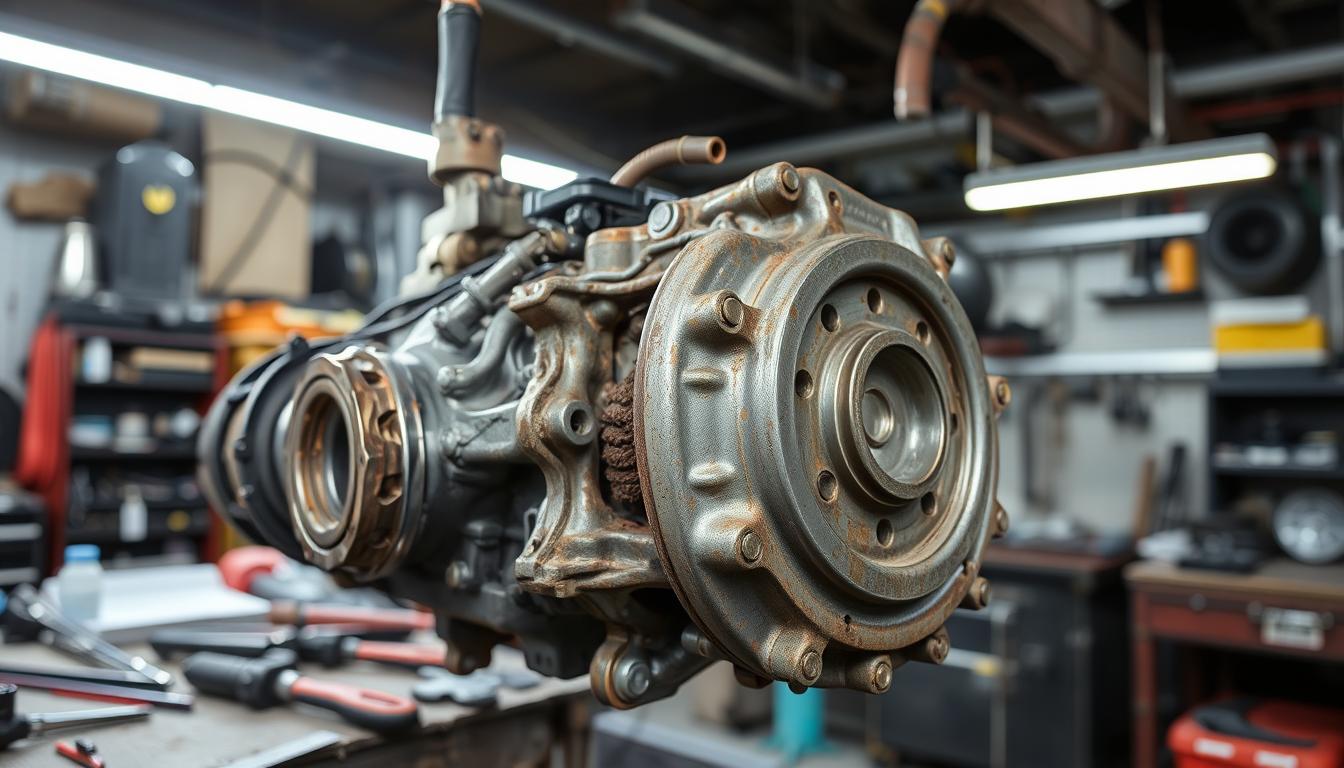The Chevrolet Silverado is known for its tough performance and reliability. It often faces specific Chevy Silverado Transfer Case Problems that can affect how well it works. Models like the NP136 and NP261 have had their own set of issues.
Common problems include fluid leaks, wear from design flaws, and trouble switching between two-wheel and four-wheel drive. These issues can cause Silverado Drivetrain Failures and lead to expensive repairs if not fixed early. Knowing about these problems is key for Silverado owners to keep their vehicles running well.
Key Takeaways
- Many Silverado models, from 2000 to 2013, often have transfer case problems.
- Checking for fluid leaks regularly can stop big damage to the transfer case.
- Installing a “case saver” can help avoid pump rub issues at a lower cost.
- Electrical issues, like problems with the transfer case control module, can cause service 4WD warnings.
- Knowing the signs of transfer case failures can save time and money on repairs.
- Getting help from experts like the Advanced Transmission Center can give accurate diagnoses.
- Ignoring small problems can lead to big and costly repairs later on.
Understanding the Transfer Case in Chevy Silverado
The transfer case is key in the Chevy Silverado’s drivetrain, mainly for 4WD models. It sends power to both front and rear wheels, adjusting to different driving situations. Knowing how it works helps Silverado owners spot any problems.
What is a Transfer Case?
A transfer case is a special gearbox for 4WD systems. It sends power from the transmission to the axles for better traction on tough terrains. It has low and high ranges for different driving needs.
Functionality of the Transfer Case
The transfer case functionality does more than just send power. It uses a chain drive and various gear ratios for the best performance. It changes how power is sent based on the drive mode, helping with towing and off-road driving.
Different Types of Transfer Cases
In the Chevy Silverado, there are different types of transfer cases for different needs. Some common ones are:
- NP136
- NP146
- NP246
Knowing these types helps owners understand their Chevy Silverado drivetrain mechanics better. This way, they can spot and fix any issues sooner.
Common Symptoms of Transfer Case Problems
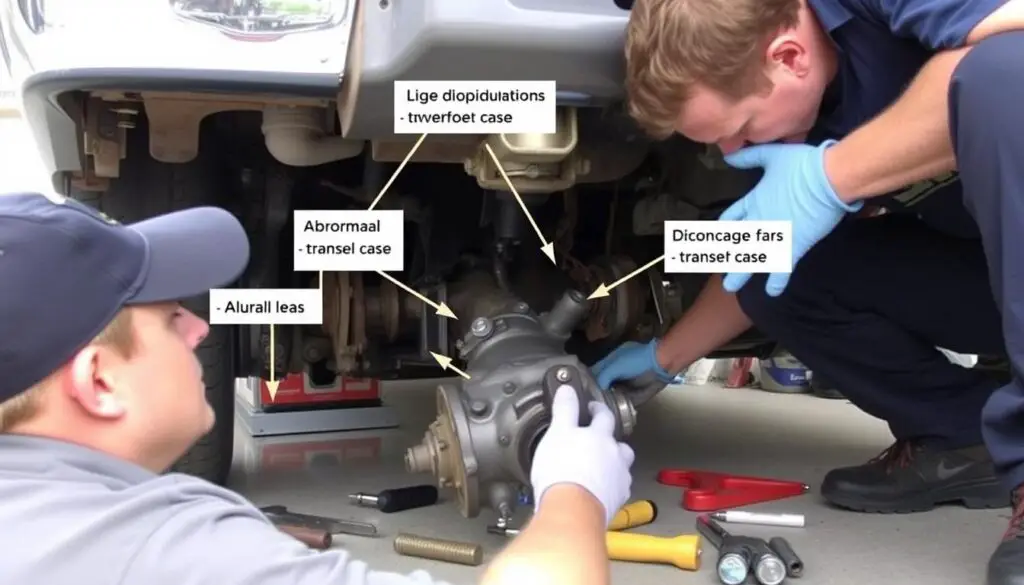
It’s important to know the signs of transfer case trouble in a Chevy Silverado. Spotting issues early can avoid expensive fixes and damage. Look out for these common signs that your transfer case might be failing.
Unusual Noises When Shifting Gears
If you hear Chevy Silverado noise when shifting gears, it could mean trouble. Grinding, clunking, or whining sounds usually mean parts are wearing out. Fixing these noises quickly can stop bigger problems in the drivetrain.
Difficulty Engaging Four-Wheel Drive
Having trouble with four-wheel drive might mean your transfer case is failing. If it doesn’t engage right or keeps disengaging, it’s a big problem. Fixing this fast is key to keeping your vehicle safe.
Warning Lights on the Dashboard
Transfer case warning lights on your dashboard mean something’s wrong. Don’t ignore these lights, as they show serious issues that need fixing fast. Ignoring them can make things worse and risk your safety.
Knowing these signs can help you fix problems before they get worse. This keeps your Chevy Silverado safe and reliable on the road.
Causes of Transfer Case Issues in Chevy Silverado
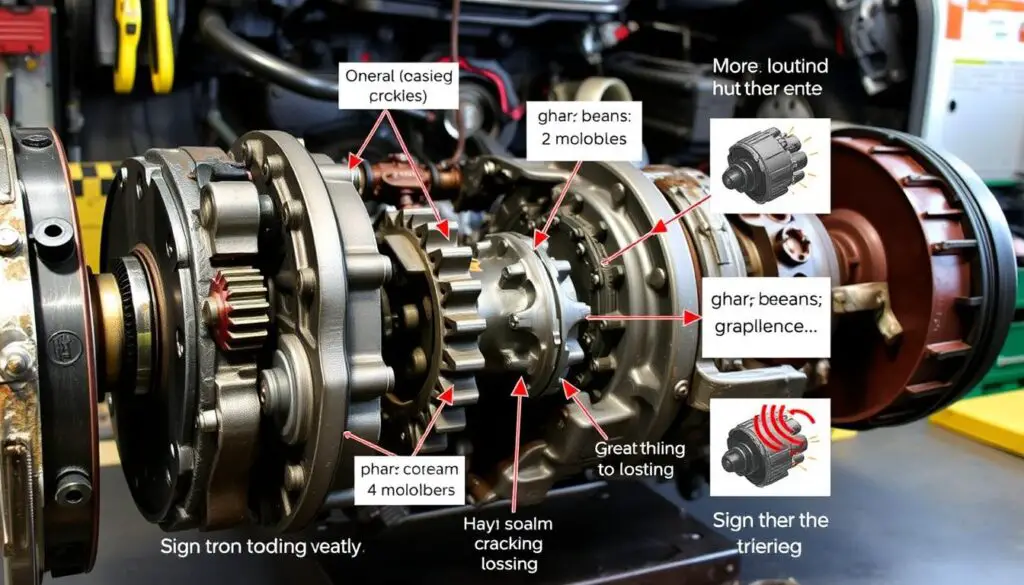
The causes of Chevy Transfer Case issues are often the same. Knowing these can help Silverado owners fix problems early. Common issues include fluid leaks, gear wear, and electrical problems.
Fluid Leaks
Fluid leaks from the transfer case are a big problem. They come from a design flaw called pump rub. This flaw can damage the transfer case over time.
Fluid leaks can cause big problems. They can lead to poor lubrication and more wear on gears. This can cost a lot to fix.
Worn or Damaged Gears
As a Chevy Silverado gets older, gear wear is more likely. Worn gears can make the transfer case work poorly. This is true for 4WD engagement.
This damage happens slowly. But, if not fixed, it can cause big problems.
Electrical Problems Affecting Operation
Electrical issues in the transfer case can also cause problems. For example, a bad transfer case switch can send wrong signals. This can turn on the 4WD warning light for no reason.
Issues with the transfer case control module can also cause trouble. They can make it hard for drivers to know if 4WD is working right.
| Causal Factor | Description | Potential Consequences |
|---|---|---|
| Fluid Leaks | Leakage from the transfer case due to pump rub | Improper lubrication, increased wear, potential catastrophic failure |
| Worn Gears | Gradual wear of internal gears over time | Impairment of transfer case functionality, expensive repairs |
| Electrical Issues | Malfunctioning electrical components impacting transfer case control | Unnecessary warning lights, incorrect signals, operational confusion |
Diagnosing Transfer Case Problems
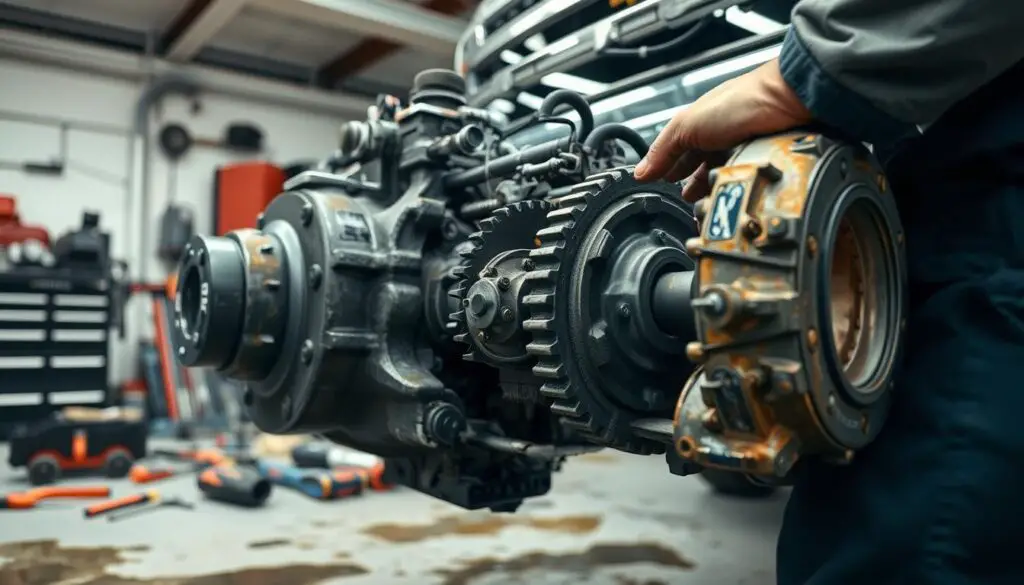
Figuring out problems with the transfer case in a Chevy Silverado needs a careful plan. First, look for any leaks or damage. Then, use special tools to get more info. Ignoring these signs can cause bigger problems, so it’s key to know how to check.
Visual Inspections
Start by doing a detailed look. Check for:
- Fluid leaks around the transfer case.
- Signs of wear on the gears or housing.
- Worn or damaged wiring, specially near the shifting parts.
For example, broken wires near the front axle can mess up the transfer case. Fixing these problems early can stop more damage.
Using Diagnostic Tools
Diagnostic tools are key for a detailed check. They can show error codes in the car’s computer. For instance, code B2725 means a problem with the transfer case mode switch. Tools also check the voltage of the selector switch, giving important info.
| Transfer Case Mode | Correct Voltage Reading (v) | Actual Voltage Reading (v) |
|---|---|---|
| Auto 4WD | 3.22 | 4.79 |
| 2H | 4.05 | 2.03 |
| 4H | 2.40 | 3.09 |
| 4L | 1.57 | 1.53 |
Any big differences in readings mean you need to look closer. These differences can show problems that need more checking.
When to Consult a Professional Mechanic
If you can’t figure out the problem, get help from a mechanic. A pro can understand the data and fix it right. For example, a known problem with the transfer case switch assembly shows why you need a pro.
Maintaining Your Chevy Silverado Transfer Case
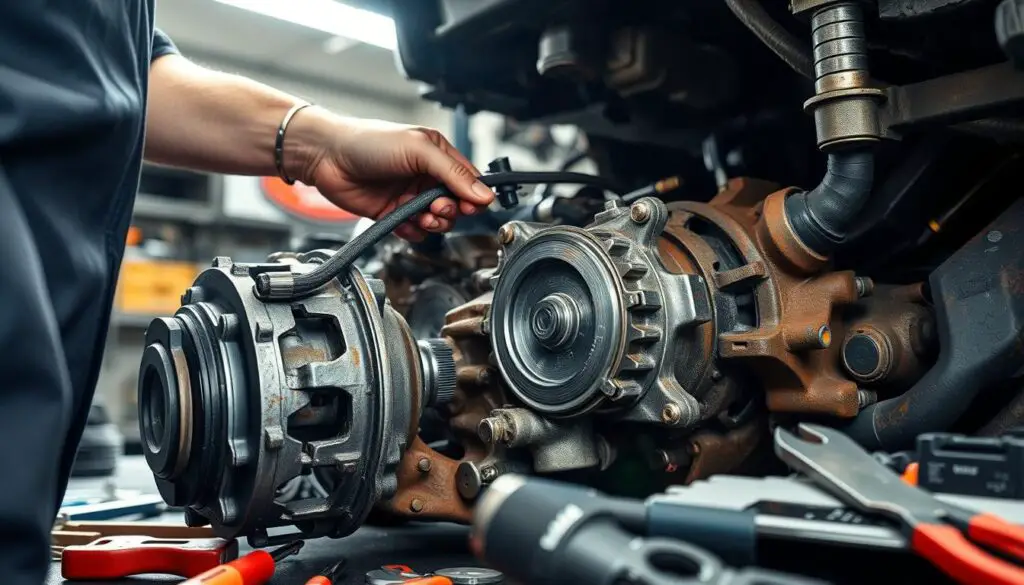
Keeping your Chevy Silverado transfer case in good shape is key. Regular care helps avoid expensive fixes later. Focus on fluid changes, seal checks, and listening for odd sounds.
Regular Fluid Changes
Fluid changes keep things running smoothly. The transfer case needs Auto-Trak II or automatic transmission fluid. Skipping these changes can cause overheating and damage.
Make it a habit to change the fluid regularly. This keeps your transfer case working well.
Checking Seals and Gaskets
Seal checks are crucial for a leak-free system. Over time, seals can wear out, causing fluid loss. Look for signs of wear or leaks around the seals.
Fixing any issues early keeps your transfer case healthy.
Monitoring for Unusual Sounds
Listen for odd sounds while driving. Grinding, clunking, or whining might mean trouble. Catching problems early helps keep your vehicle running smoothly.
Transfer Case Repair Options
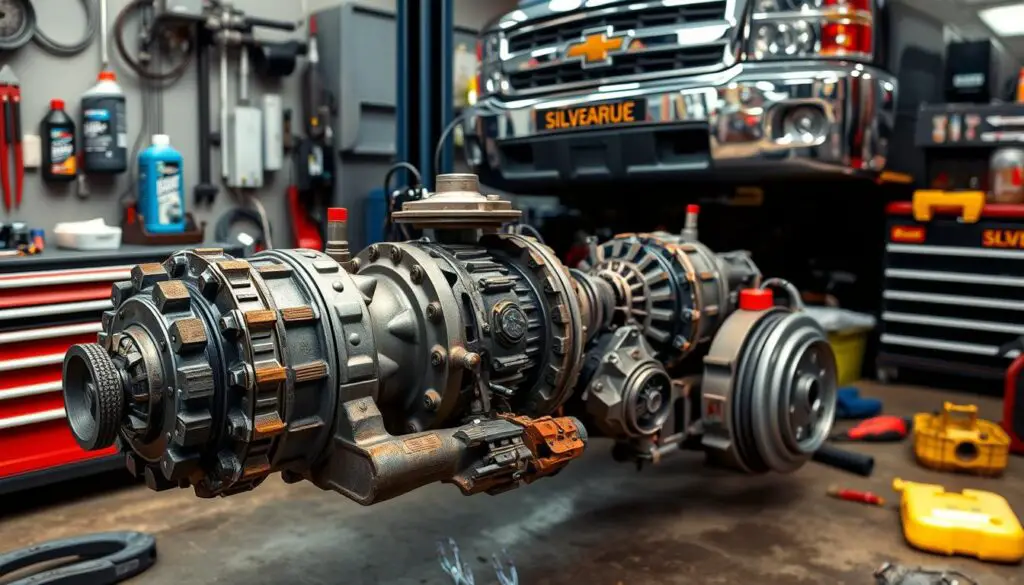
When a 2013 Chevy Silverado 1500 has transfer case problems, owners look at different repair choices. They must decide between fixing it themselves or getting help from experts. Some repairs are easy to do at home, but others need a pro’s touch.
DIY Repairs vs. Professional Help
Many truck owners like to fix small problems themselves. Simple tasks like fluid changes can be done at home. But, complex issues like a C0306-5 code need a pro’s help. Experts can save time and money, and prevent big damage.
Common Repair Techniques
There are a few ways to fix transfer case problems:
- Fluid Change: Changing the transfer case fluid regularly keeps it working right.
- Inspections: Checking the transfer case control module (TCCM) and its pins can spot early issues.
- Case Saver Installation: Putting in a case saver can stop pump rub and save repair costs later.
Replacement of the Transfer Case
If repairs are too hard, you might need to replace the transfer case. This means taking out the old one and putting in a new or fixed one. It’s best to let experts like Advanced Transmission Center do this. They know how to install it right and avoid future problems.
Transfer Case Preventive Measures
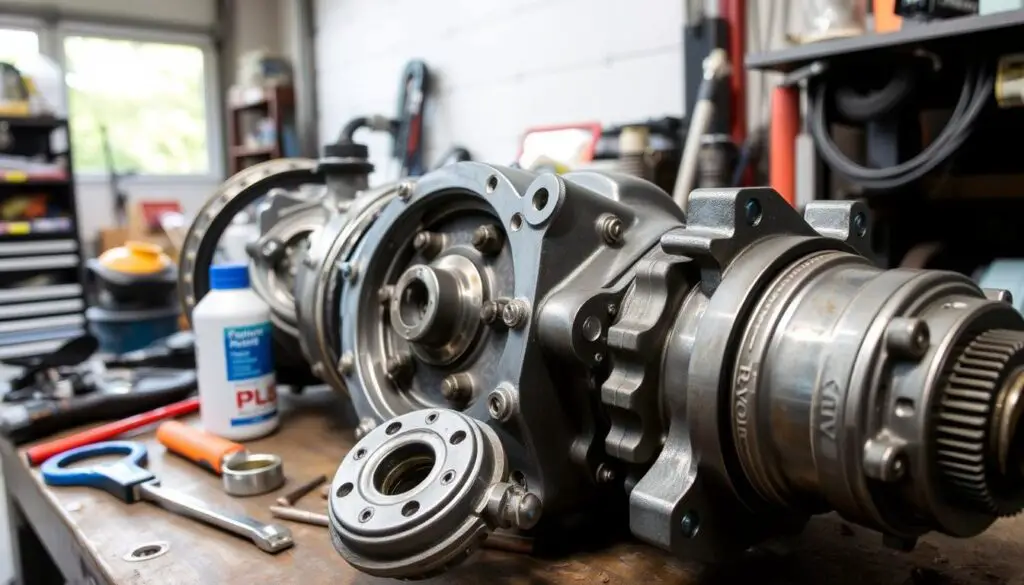
Keeping your Chevy Silverado’s transfer case in good shape can save you money and ensure it works well. It’s key to follow preventive measures to make your vehicle last longer. By following Silverado maintenance tips and avoiding overloading, you can keep your transfer case running smoothly.
Routine Maintenance Tips
Regular care is vital for your transfer case to work right. Here are some tips:
- Fluid Inspection: Always check the transfer case fluid levels and quality to prevent damage.
- Fluid Replacement: Swap out the transfer case fluid every 30,000 to 50,000 miles for best performance.
- Visual Checks: Look for leaks, cracks, or wear signs to catch problems early.
Importance of Timely Repairs
Fixing issues quickly can save you money later. Ignoring small problems can lead to big repairs, like with the transfer case. Catching problems early is key to a healthy transfer case. If you notice odd noises or trouble with four-wheel drive, get help fast.
Avoiding Overloading Your Vehicle
Overloading can hurt your transfer case’s performance. Remember your Silverado’s towing and payload limits. Exceeding these can wear out the transfer case and cause it to fail. Stick to the manufacturer’s weight guidelines to avoid early breakdowns.
Cost Implications of Transfer Case Repairs
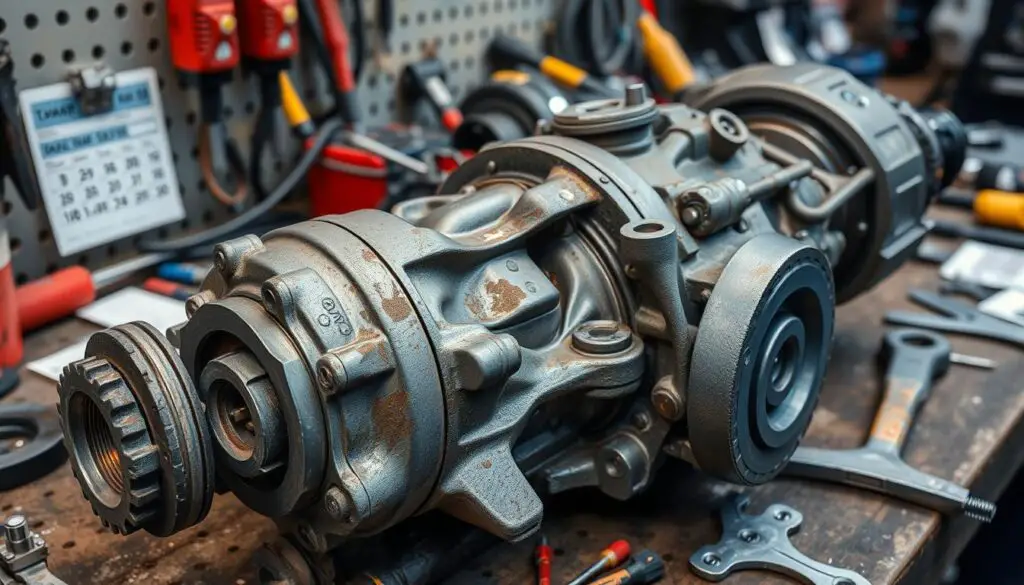
Knowing the costs of fixing a Chevy Silverado’s transfer case is key for budgeting. Many things affect the price, like how bad the damage is, what parts you need, and mechanic rates. Knowing average repair costs helps you get ready for future problems.
Factors Affecting Repair Costs
Several things add up when fixing a transfer case. These include:
- Type of repair: How complex the fix is changes labor and parts costs.
- Parts needed: Prices change based on the parts needed for the fix.
- Mechanic’s labor rates: Rates differ a lot between shops.
Average Costs for Common Repairs
Repairing or replacing a transfer case can cost a lot. Here are some common prices:
| Repair Type | Cost Range | Parts Cost |
|---|---|---|
| Transfer Case Replacement | $2,000 – $8,000 | $2,400 |
| Repairing Encoder Ring | $425 – $800 | $30 – $60 |
| Half Transfer Case Replacement | $450 – $675 | $115 – $150 |
| Labor Costs | $75 – $130 per hour | N/A |
| Average Labor for Removal/Replacement | 3.5 hours | N/A |
Warranty and Insurance Considerations
The warranty for a Chevy Silverado can help with costs. A valid warranty can lower what you pay for repairs. Insurance might also help, if the damage was from an accident or something unexpected. Looking into financing options like saving money, using credit cards, or personal loans can also help with the cost.
Conclusion: Keeping Your Chevy Silverado in Top Shape
Keeping your Chevy Silverado in good shape is key for its long life and reliability. Regular care helps avoid sudden breakdowns and boosts performance. It’s crucial for car owners to know what maintenance their truck needs, like fluid changes and system checks, to avoid expensive fixes later.
Importance of Regular Maintenance
Regular care for your Chevy Silverado, like the transfer case and 4WD system, is very important. It’s suggested to change transfer case fluid every 30,000 miles. This helps keep your vehicle running smoothly and prevents problems like vibrations and 4WD issues.
Following these maintenance schedules keeps your Chevy truck ready for any drive. It ensures your truck stays in top shape.
Staying Informed About Potential Issues
Knowing about common transfer case problems is very helpful. Issues like strange noises and warning lights can be fixed early. Using Chevy truck resources gives owners the knowledge they need to care for their vehicle and catch problems early.
Resources for Chevy Silverado Owners
Using resources made for Chevy Silverado owners helps make smart choices about maintenance and repairs. Whether it’s online forums, service manuals, or trusted mechanics, staying informed keeps your Silverado running well. It also keeps its value in a competitive truck market.
FAQ
What are common Chevy Silverado transfer case problems?
How can I identify symptoms of transfer case problems in my Chevy Silverado?
What causes transfer case issues in Chevy Silverados?
How do I diagnose transfer case problems?
What maintenance should I perform on my Chevy Silverado transfer case?
Are there options for transfer case repair?
What preventive measures can I take to avoid transfer case problems?
How much can I expect to pay for transfer case repairs?

Jack Thompson is a writer and seasoned auto mechanic with over 15 years of experience in the automotive industry. Known for his expertise in vehicle mechanics, Jack has a deep understanding of car and truck systems. His skills, honed through years of hands-on experience, have made him a trusted name in the field. Jack is committed to providing valuable insights into car maintenance and repair, helping vehicle owners keep their vehicles in top condition.

